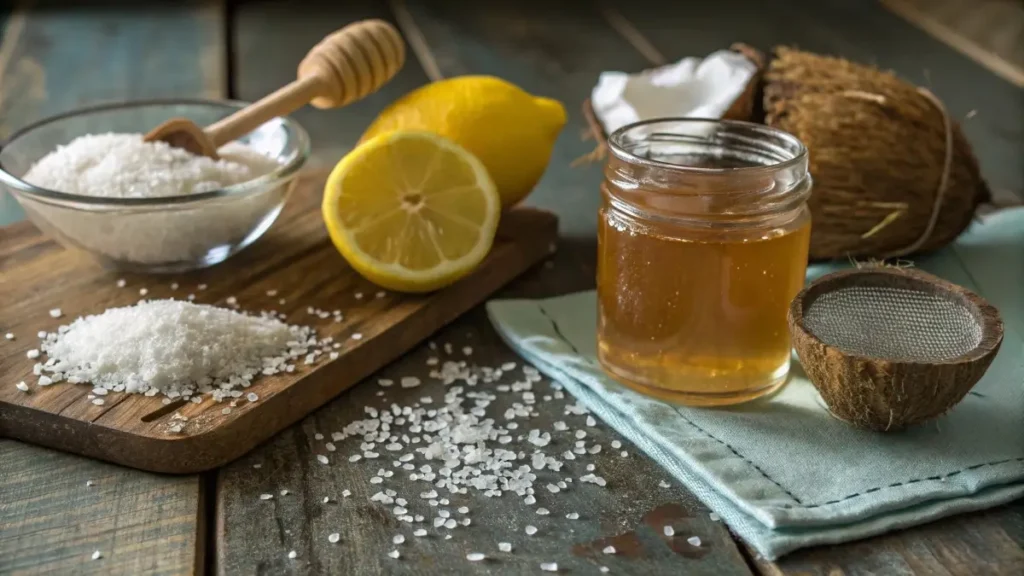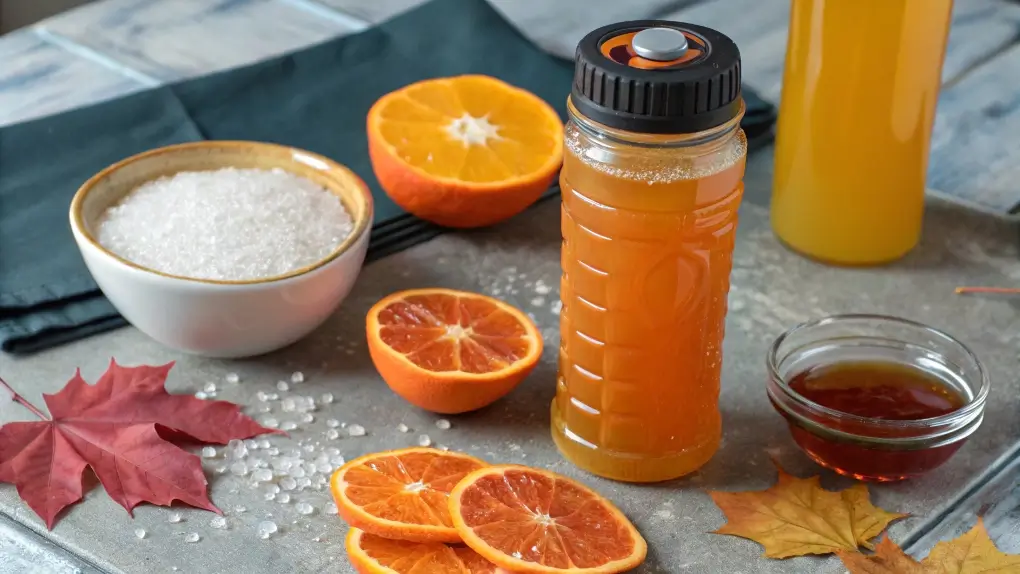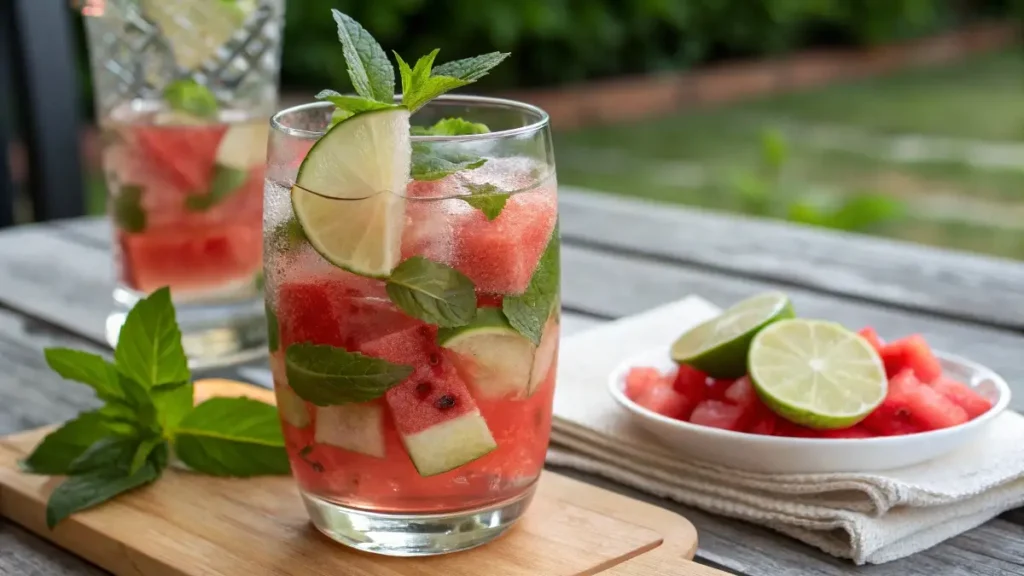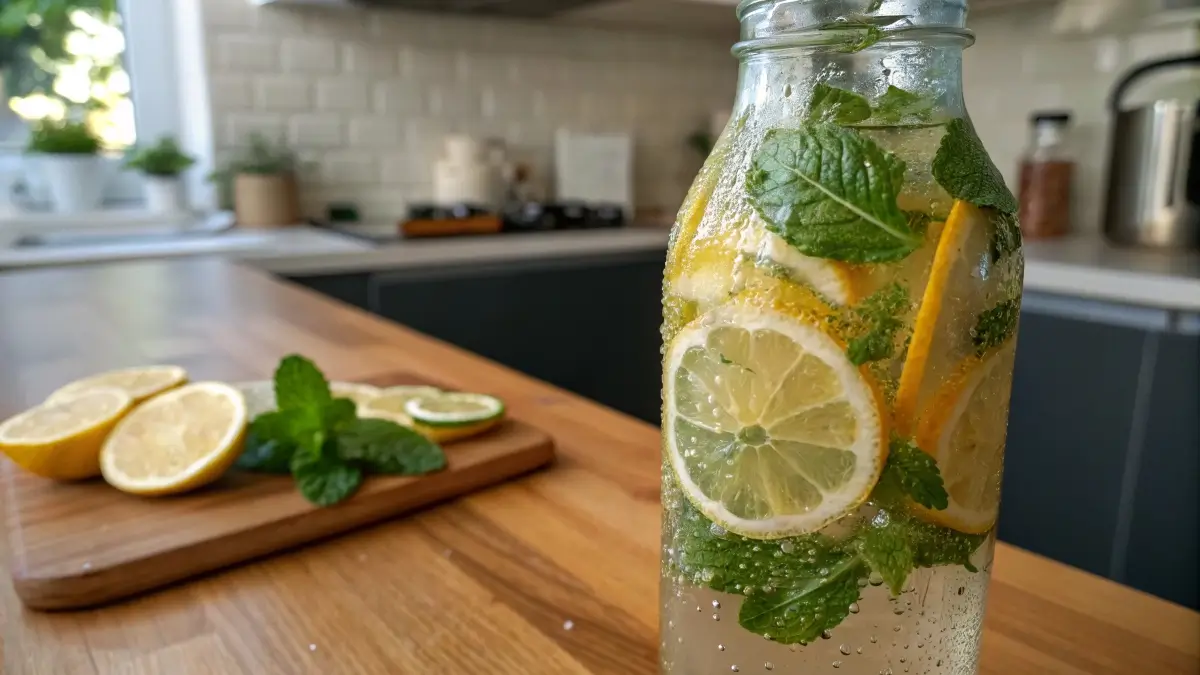Homemade Energy Drink Recipe: The Ultimate Guide to Natural Energy Boosters
Looking for a way to fuel your body without the extra sugar, artificial colors, or chemicals found in commercial options? A homemade energy drink recipe can be your perfect solution. In this comprehensive guide, we’ll explore how to create healthy, budget-friendly energy drinks using simple ingredients right from your kitchen. From basic recipes and quick energy boosters to DIY Gatorade alternatives, you’ll learn everything you need to power through your day naturally.
Discover great ideas like this detox island green smoothie to complement your energy drinks.
Table of Contents
Introduction to Homemade Energy Drink Recipes
What is a homemade energy drink recipe?
A homemade energy drink recipe is a simple, customizable formula you can whip up using natural ingredients to enhance hydration, replenish electrolytes, and provide a clean energy boost. Unlike store-bought energy drinks loaded with synthetic additives, these DIY options rely on fresh fruits, minerals, and natural sweeteners. You’re in full control of what goes into your drink, which means fewer chemicals and more goodness. Plus, making energy drinks at home can save you money while letting you tailor the taste to your liking.
Many homemade recipes focus on key ingredients like coconut water, citrus fruits, sea salt, honey, and herbal teas. These not only provide hydration but also essential nutrients that help with energy production and muscle recovery. A DIY drink can be as simple or as advanced as you want, depending on your needs—whether it’s a light afternoon refresher or a serious post-workout rehydrator.
Why choose homemade over store-bought energy drinks?
There’s a long list of reasons why people are switching to homemade energy drink recipes. First off, store-bought options often contain high levels of sugar, artificial sweeteners, synthetic caffeine, preservatives, and colorings. While these ingredients may deliver a short-lived burst of energy, they can lead to crashes, jitters, or unwanted side effects like headaches or heart palpitations.
Homemade energy drinks, on the other hand, let you control every ingredient that goes into your body. You can choose natural sugars (like honey or maple syrup), skip artificial flavors, and adjust the electrolyte levels to match your specific hydration needs. This is especially valuable for athletes, fitness enthusiasts, and anyone aiming for a cleaner diet.
Let’s not forget about cost and sustainability. Creating your own energy drinks at home is significantly cheaper in the long run. Plus, you reduce packaging waste by using reusable bottles and jars. Making your own energy drinks saves money and reduces waste—a smart move for your budget and the planet.
In this guide, we’ll walk you through everything from how to make an energy drink at home to creating your own electrolyte sports drink safely. You’ll get simple recipes, pro tips, and answers to common questions so you can confidently make the switch to natural energy boosters.
Essential Ingredients for a Homemade Energy Drink
Top 5 ingredients commonly found in homemade energy drinks
If you’re wondering what goes into a powerful and clean homemade energy drink recipe, here’s a closer look at the top ingredients that make a real difference in both hydration and energy levels:
- Coconut water – Often called nature’s sports drink, coconut water is packed with natural electrolytes like potassium and magnesium. It helps replenish what your body loses through sweat, especially after exercise.
- Citrus fruits (like lemon, lime, or orange juice) – These fruits add a refreshing taste and a dose of vitamin C. Plus, their natural sugars provide quick, clean-burning energy.
- Natural sweeteners (honey or maple syrup) – Instead of relying on refined sugars, homemade recipes often use honey or maple syrup. These sweeteners not only enhance flavor but also deliver trace minerals and antioxidants.
- Sea salt or Himalayan pink salt – A pinch of natural salt adds essential sodium, helping your body retain fluids and maintain a healthy electrolyte balance.
- Herbal teas or green tea – For those looking for a mild caffeine kick without synthetic additives, herbal teas like ginger, hibiscus, or green tea offer natural energy and antioxidants.
Combining these ingredients creates a balanced drink that hydrates, energizes, and nourishes your body without the downsides of commercial products.
Benefits of natural ingredients over artificial additives
When it comes to boosting energy, not all ingredients are created equal. Most commercial energy drinks contain artificial sweeteners, lab-made caffeine, preservatives, and artificial dyes. These additives can cause side effects like energy crashes, increased heart rate, or digestive issues.
On the flip side, using natural ingredients in your homemade energy drink recipe means you’re giving your body what it actually needs. Coconut water provides real electrolytes. Citrus fruits offer natural sugars along with vitamins. Honey gives you energy plus a nutritional bonus. Even the salt you add brings necessary minerals to the mix.
Choosing natural over artificial helps you avoid unnecessary chemicals and keeps your drink clean, simple, and effective. You’ll notice the difference not just in taste, but in how your body feels after drinking it. Clean energy means sustained energy—no jitters, no crashes.
Looking for inspiration? Try this iced vanilla matcha latte for another natural energy idea that’s easy to make at home.
How to Make an Energy Drink at Home (Step-by-Step)

Simple base recipes for homemade energy drinks
Making your own energy drink at home is easier than you think. Start with a hydrating base like coconut water or plain water. Add a splash of lemon or lime juice for flavor and vitamin C. Stir in a teaspoon of honey or maple syrup for natural sweetness and quick energy. Finally, don’t forget a pinch of sea salt or Himalayan pink salt to replace lost sodium.
You can also brew herbal or green tea and use that as a base. Green tea brings a gentle caffeine boost, while herbal options like hibiscus add antioxidants. For more ideas on how to create balanced drinks, discover great ideas like the detox island green smoothie from All Recipes Dishes.
Customization tips for flavor and nutrition
Once you’ve got the basics down, it’s time to personalize your drink. Mix in chia seeds for added fiber and omega-3s. Use fresh mint or basil for a refreshing twist. If you prefer a fruity touch, blend in berries or watermelon.
Athletes can benefit from a mix of coconut water and orange juice—rich in natural sugars and electrolytes, it’s an excellent substitute for commercial sports drinks. Don’t miss our iced vanilla matcha latte recipe, which shows another way to get a natural energy boost without artificial ingredients.
Homemade drinks give you the freedom to adjust the sweetness, acidity, and mineral content. That way, you’re in control of both taste and nutrition—something store-bought options can’t offer.
Best Homemade Electrolyte Sports Drink Recipes
DIY electrolyte drinks for athletes
Sweating depletes key electrolytes such as sodium, potassium, and magnesium. A well-balanced homemade energy drink can quickly replenish these essential nutrients. A simple recipe includes coconut water, a splash of orange juice, a teaspoon of honey, and a pinch of sea salt—hydrating and energizing with zero artificial additives.
Another favorite is lemon water with maple syrup, salt, and a touch of ginger. The ginger can help with digestion and adds a subtle kick. For more hydration ideas, check out our guide on frozen drinks, packed with refreshing tips for hot days.
Balancing salt, sugar, and water for optimal hydration
The key to making a great electrolyte drink at home is balance. Too much salt can make it taste off, while too much sugar defeats the purpose of a healthy drink. Aim for about ⅛ teaspoon of salt per 2 cups of fluid, with 1 to 2 teaspoons of natural sweetener. Adjust to taste, but keep it light and refreshing.
Adding fresh fruit like berries or watermelon not only improves the flavor but also brings extra vitamins and antioxidants. If you want a fun twist, discover great ideas like the iced vanilla matcha latte that combines hydration and natural caffeine in one.
Homemade sports drinks aren’t just for workouts. They’re great for staying hydrated during busy days, outdoor activities, or even when recovering from illness.
Instant Energy Drinks You Can Make at Home
Quick recipes for an energy boost
Sometimes, you just need a fast energy fix without the fuss. A simple homemade energy drink recipe for instant energy is mixing cold green tea with lemon juice, honey, and a few ice cubes. Green tea delivers a mild caffeine lift while honey gives a quick hit of natural sugar.
If you’re short on time, stir a teaspoon of maple syrup and a pinch of salt into coconut water. This fast DIY option restores lost electrolytes and helps keep you going. Looking for inspiration? Try something like our detox island green smoothie, a refreshing option that’s packed with nutrients and flavor.
Ingredients that provide immediate vitality
For rapid energy, it’s best to stick with ingredients your body can absorb easily. Natural sugars from honey or fruit juice give you a quick boost. Coconut water rehydrates fast thanks to its electrolyte content. A squeeze of lemon or lime not only brightens the flavor but also helps with absorption of minerals.
If you want a slightly creamy twist, add a splash of plant-based milk or blend in a banana for extra potassium. Discover great ideas like the iced vanilla matcha latte, which offers both flavor and a gentle energy lift without added junk.
Homemade instant energy drinks are perfect before workouts, during long meetings, or whenever you need a quick pick-me-up the natural way.
Homemade Gatorade Alternatives

How to replicate Gatorade at home
Gatorade is popular for hydration and electrolytes, but you don’t need to buy it to get the same benefits. A smart homemade energy drink recipe can do the job, minus the artificial colors and high sugar content. Start with two cups of water or coconut water. Add ¼ cup of orange juice, 2 tablespoons of lemon juice, 1 to 2 teaspoons of honey or maple syrup, and ⅛ teaspoon of sea salt. Stir well, chill, and enjoy a refreshing sports drink that’s clean and effective.
For a refreshing twist, try blending watermelon juice with lime and a touch of salt for a naturally sweet and hydrating drink.
Check out our frozen drinks guide for more ideas on turning your DIY energy drink into a fun, cooling treat.
Cost-saving and health benefits of DIY sports drinks
Making your own Gatorade-style drink at home isn’t just healthier—it’s cheaper too. Commercial sports drinks can cost quite a bit, especially if you’re consuming them regularly. With a homemade recipe, you get all the hydration and electrolyte benefits for a fraction of the price.
Plus, you avoid unnecessary additives. No food dyes, no preservatives, just real ingredients. If you love experimenting with flavors, don’t miss our iced vanilla matcha latte, which offers a unique take on natural energy.
DIY sports drinks also let you reduce waste by using reusable bottles, making them a smart choice for your wallet and the planet.
The Science Behind Energy Drinks
How natural energy drink ingredients work
When you sip on a homemade energy drink, you’re giving your body more than just fluid. Each ingredient plays a role in boosting energy and hydration. Natural sugars from honey, maple syrup, or fruit juice provide quick fuel your muscles can use right away. Coconut water offers potassium, which helps prevent muscle cramps. Citrus juice not only refreshes your palate but also supplies vitamin C, which supports overall health.
Green tea or herbal tea bases give a gentle caffeine lift or antioxidant power. The salt you add replaces sodium lost through sweat, helping your body hold onto the water it needs. If you’re curious about other drinks that balance flavor and nutrition, don’t miss our take on the detox island green smoothie — it’s packed with natural goodness.
Electrolytes, carbs, and caffeine explained
Electrolytes—such as sodium, potassium, magnesium, and calcium—are crucial for maintaining hydration, nerve signals, and muscle performance. In homemade energy drinks, ingredients like sea salt and coconut water are your main sources. Carbs, mainly from natural sweeteners or fruit, give your body fast energy to burn.
Unlike many store-bought options, you can control the amount of caffeine in your DIY drinks. A brewed green tea base adds a little kick without the crash, while herbal teas keep things caffeine-free. For a fun and functional option, explore our frozen drinks guide, which features creative ways to stay cool and hydrated.
Homemade recipes let you customize every element so you get what your body really needs—nothing more, nothing less.
Safety Tips and Common Mistakes to Avoid
Overuse of stimulants and sugars
While a homemade energy drink recipe offers lots of benefits, it’s easy to go overboard with certain ingredients. Adding too much honey, maple syrup, or fruit juice can turn your healthy drink into a sugar bomb. This might give you a fast energy rush, but it could also lead to a crash later. Aim for 1–2 teaspoons of natural sweetener per serving.
It’s the same with caffeine. Using too much green tea or adding strong coffee can cause jitters, headaches, or trouble sleeping. Keep the caffeine content light unless you really need that extra kick. If you want a gentler energy source, check out our iced vanilla matcha latte, a tasty way to stay alert without going overboard.
Safe storage and shelf life of homemade drinks
Homemade drinks don’t have preservatives, so they won’t last as long as store-bought options. Always keep your DIY energy drink in the fridge and drink it within 24 hours for the best taste and safety. If you’re making a large batch, store it in a clean, airtight bottle to prevent contamination.
Be sure to shake or stir your drink before serving, as natural ingredients can separate over time. For ideas on keeping your drinks fresh and exciting, explore our frozen drinks guide, which includes creative, cool recipes perfect for summer.
Creative Variations on Homemade Energy Drinks

Fruit-infused energy drinks
One of the easiest ways to level up your homemade energy drink recipe is by infusing it with fresh fruit. Try adding slices of cucumber, orange, or strawberry to your drink. Not only do these add a burst of flavor, but they also provide extra vitamins and antioxidants.
Watermelon juice mixed with lime and a pinch of salt creates a naturally sweet, hydrating option that’s perfect for hot days. You can even toss in some fresh mint or basil for an extra layer of refreshment. For more ideas on fun, hydrating recipes, don’t miss our frozen drinks guide loaded with creative combos.
Herbal and tea-based energy drink recipes
Herbal teas like hibiscus, ginger, or chamomile can form the base of unique energy drinks. These provide a gentle boost, with added health perks like antioxidants or digestive support. Brew your tea, let it cool, and then mix in citrus juice, honey, and a dash of salt.
If you’re looking for something with a little caffeine, try green tea or matcha as a base. These bring a mild lift without the harsh spike and crash that often comes with commercial energy drinks. A great example of blending flavor with function is our iced vanilla matcha latte, a satisfying and clean energy option.
Experimenting with different ingredients lets you tailor your drink to your taste and energy needs. Plus, it keeps things interesting so you’ll never get bored with your homemade creations.
Conclusion
Creating your own homemade energy drink recipe is one of the easiest and smartest ways to fuel your body naturally. With just a few simple ingredients like coconut water, citrus juice, honey, and a pinch of salt, you can hydrate, replenish electrolytes, and enjoy clean, sustained energy. Not only does this save money, but it also helps you avoid the unnecessary additives found in commercial drinks. Whether you need a quick boost before a workout or a refreshing drink on a hot day, homemade energy drinks give you the freedom to customize your flavor and nutrition. Don’t miss our guide on frozen drinks for more fun hydration ideas.
FAQs
How to make an energy drink at home?
Making an energy drink at home is simple. Start with a hydrating base like coconut water or plain water. Add fresh lemon or lime juice for vitamin C and flavor. Mix in 1 to 2 teaspoons of honey or maple syrup for natural sweetness. Finally, add a pinch of sea salt to restore sodium lost through sweat. Chill and enjoy! This basic homemade energy drink recipe can be adjusted with herbs, fruit, or tea for variety.
What are the top 5 ingredients in an energy drink?
The top 5 ingredients in a clean, natural energy drink include coconut water, citrus juice (like lemon or orange), natural sweeteners (such as honey), sea salt or Himalayan pink salt, and herbal or green tea. These work together to hydrate, provide quick energy, and replace electrolytes. For inspiration on using similar ingredients in other drinks, check out our detox island green smoothie recipe that also focuses on natural energy.
What to drink for instant energy at home?
For quick energy, mix green tea (cooled) with lemon juice, honey, and ice. The green tea provides a gentle caffeine boost, while honey offers fast-absorbing natural sugar. Coconut water with a splash of orange juice and a pinch of salt is another fast, hydrating option. If you’re looking for other refreshing ideas, try our frozen drinks guide for tasty options that cool and energize.
How to make your own electrolyte sports drink?
To make a homemade electrolyte sports drink, combine two cups of water or coconut water, ¼ cup of orange juice, 2 tablespoons of lemon juice, 1 teaspoon of honey or maple syrup, and ⅛ teaspoon of sea salt. Mix well and serve cold. This DIY drink replaces electrolytes and keeps you hydrated without artificial ingredients. It’s a simple, cost-effective alternative to commercial sports drinks.
Can I just add salt to water for electrolytes?
While adding salt to water does provide sodium, it’s not enough on its own for a complete electrolyte drink. Your body also needs potassium, magnesium, and carbohydrates for balanced hydration. That’s why recipes with coconut water, citrus, and natural sweeteners are better options. They help replenish multiple nutrients, not just sodium.
How to make homemade Gatorade?
Homemade Gatorade is easy and customizable. Mix two cups of water, ¼ cup of orange juice, 2 tablespoons of lemon juice, 1 to 2 teaspoons of honey or maple syrup, and a pinch of sea salt. Stir well and chill. This natural version hydrates and fuels you without the artificial colors and high sugar levels found in the store-bought kind. For other ways to stay refreshed, don’t miss our iced vanilla matcha latte for a clean energy boost.

